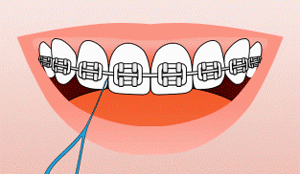Home - All About Braces - Life with Braces - Brushing and Flossing with Braces

Brushing & Flossing with Braces
Why Oral Hygiene Matters More with Braces
Braces create extra places for food and plaque to hide, especially around brackets and wires. Without proper cleaning, this can lead to tooth decay, gum irritation, and staining.
Good hygiene can also help you avoid unnecessary appointments and delays in your treatment. Simply put: clean braces = happy mouth.
How to Brush with Braces
Brushing with braces takes a few extra steps to reach all the tricky spots.

Step-by-Step Brushing Routine:
- Use a soft-bristled toothbrush or electric toothbrush.
- Angle the bristles above the bracket and brush gently.
- Repeat below the bracket.
- Brush the chewing surfaces, inside surfaces, and gumline.
- Brush for at least two minutes.
Pro Tips:
- Use fluoride toothpaste to strengthen enamel.
- Brush after every meal and snack if possible.
- Replace your toothbrush more often—braces wear them out faster.
How to Floss with Braces
Flossing is still important, even with wires in the way. It might take longer, but your gums will thank you!

Three Ways to Floss with Braces:
- Traditional floss with a threader: Use standard dental floss with a floss threader to guide it underneath your braces wire. It takes practice, but it’s highly effective for removing plaque between teeth.
- Ortho flossers: Pre-loaded with floss and shaped to fit around braces. These are quick, convenient, and great for school or travel.
- Water flossers: A high-powered stream of water blasts away debris between teeth and around brackets. Especially helpful for kids or those with dexterity challenges.** A high-powered stream of water to blast away debris—great for younger patients or anyone who struggles with traditional floss.
How Often?
- Aim for once a day, especially at night.
Rinse, Refresh, Repeat
Mouthwash isn’t a replacement for brushing or flossing—but it’s a great add-on. Fluoride rinses strengthen enamel and help prevent cavities.
Quick Cleaning Tips for School and On-the-Go
- Rinse with water after snacks if you can’t brush.
- Carry a travel toothbrush and flossers in your backpack.
- Keep orthodontic wax with you for emergencies.
Keep Your Smile on Track
Brushing and flossing with braces might take more time, but it gets easier with practice. The better you care for your smile during treatment, the more amazing your results will be when the braces come off.
Need tips or tool recommendations? Just ask—we’re here to help.
Schedule Your Free Orthodontic Consultation
Receive a complimentary orthodontic exam and learn if Clarity Advanced Clear Braces are right for you or your child.